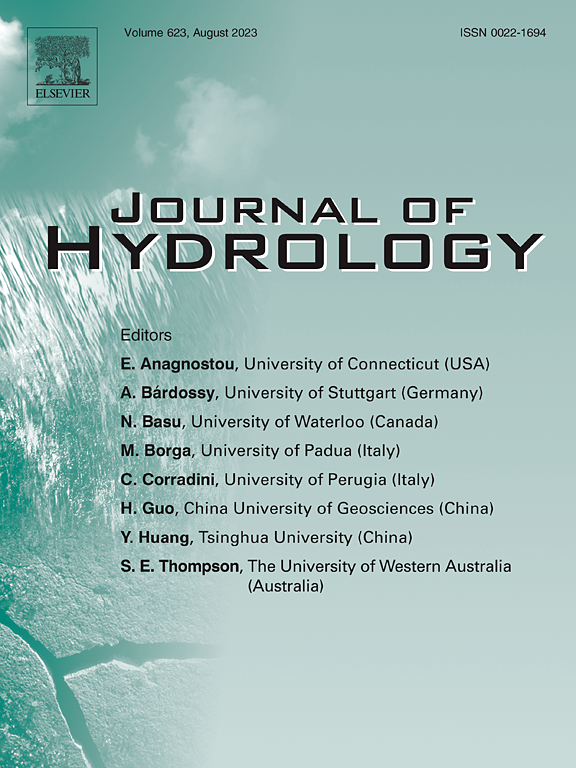平原河网城市典型社区非点源污染关键源区识别与减排计划
IF 5.9
1区 地球科学
Q1 ENGINEERING, CIVIL
引用次数: 0
摘要
人口增长和城市化导致的非点源污染日益严重,导致城市水环境恶化,平原河网区水流停滞、河道复杂等特点阻碍了非点源污染的防治和治理。因此,对平原河网区进行NSP模拟,识别关键源区,提出有效的污染减排方案,有助于平原河网区自然生态和社会经济的可持续发展。本研究以常州市新龙试验区为研究区。针对平原河网城市的特点,基于PCSWMM模型结果构建了NSP关键区域识别系统。针对确定的关键区域,构建了基于3个LID设施的9个低影响开发建设情景,并在5a、10a、30a、50a和100a 5个降雨重复周期下,分析了每个情景的峰值径流减少、管网溢流减少以及COD、TN和TSS负荷减少情况。主要研究结果如下:1)NSP关键区域为老旧居住区;2)绿化屋顶和雨水花园比例较高的情景2,在5次降雨重复情况下,峰值径流减少率分别为11.19%、11.02%、10.75%、10.63%和10.59%;3) 9个改造方案中,方案8绿化屋顶占3%,透水路面占2%,雨水花园占4%,方案8在同时实现减径流、降低管网溢流率和降低污染物负荷方面表现较好。本研究的方法和结果为平原河网城市的城市规划者和环境管理者设计更有效和可持续的NSP控制措施提供了改进和指导。本文章由计算机程序翻译,如有差异,请以英文原文为准。

Critical source areas identification and reduction plan of non-point source pollution in a typical community in a plain river network city, China
Increasing non-point source pollution (NSP) due to population growth and urbanization has caused the deterioration of urban water environments, and the characteristics of stagnant water flow and complex river channels in plain river network areas have hindered the prevention and management of NSP there. Therefore, the simulation of NSP, the identification of critical source areas and proposal of effective pollution reduction schemes for the plain river network areas can contribute to the sustainable development of the natural ecology and social economy of plain river network areas. This study takes the Xinlong pilot area in Changzhou city as the study area. A NSP critical area identification system based on the PCSWMM model results was constructed for the characteristics of the plain river network city. Nine low-impact development construction scenarios based on three LID facilities were developed for the identified critical area, and the peak runoff reduction, pipe network overflow reduction and COD, TN and TSS load reduction were analyzed for each scenario under five rainfall recurrence periods of 5a, 10a, 30a, 50a, and 100a. The main findings of this study are as follows: 1) NSP The critical areas are old residential areas; 2) Scenario 2, which includes higher proportion of green roof and rain garden, shows best performance for peak runoff reduction, achieving a reduction rate of 11.19 %, 11.02 %, 10.75 %, 10.63 %, and 10.59 % under five rainfall recurrences, respectively; and 3) Among the nine renovation scenarios, scheme 8, which allocates 3 % to green roof, 2 % to permeable pavement, and 4 % to rain garden, demonstrated relatively good performance in simultaneously achieving runoff reduction, pipe network overflow rate reduction, and pollutant load reduction. The methods and results of this study provided improvements and guidance for urban planners and environmental managers in designing more effective and sustainable NSP control measures in plain river network cities.
求助全文
通过发布文献求助,成功后即可免费获取论文全文。
去求助
来源期刊

Journal of Hydrology
地学-地球科学综合
CiteScore
11.00
自引率
12.50%
发文量
1309
审稿时长
7.5 months
期刊介绍:
The Journal of Hydrology publishes original research papers and comprehensive reviews in all the subfields of the hydrological sciences including water based management and policy issues that impact on economics and society. These comprise, but are not limited to the physical, chemical, biogeochemical, stochastic and systems aspects of surface and groundwater hydrology, hydrometeorology and hydrogeology. Relevant topics incorporating the insights and methodologies of disciplines such as climatology, water resource systems, hydraulics, agrohydrology, geomorphology, soil science, instrumentation and remote sensing, civil and environmental engineering are included. Social science perspectives on hydrological problems such as resource and ecological economics, environmental sociology, psychology and behavioural science, management and policy analysis are also invited. Multi-and interdisciplinary analyses of hydrological problems are within scope. The science published in the Journal of Hydrology is relevant to catchment scales rather than exclusively to a local scale or site.
 求助内容:
求助内容: 应助结果提醒方式:
应助结果提醒方式:


